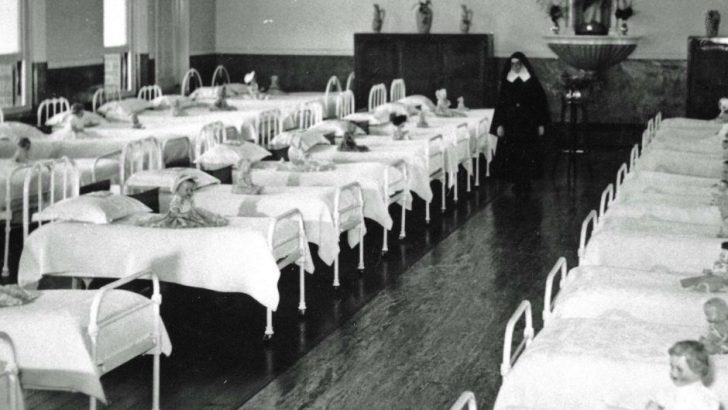Every society has treated ‘unwanted’ children as a problem, writes David Quinn
As with the Magdalene homes, mother and baby homes have developed a strong attachment in the public mind with both Ireland and Catholicism. That is to say, these institutions seem peculiar to Irish Catholicism. This linkage in the public mind is likely to be strengthened by a new book called The Adoption Machine: The Dark History of Ireland’s Mother and Baby Homes which is currently receiving plenty of media coverage.
Ireland’s mother and baby homes have been receiving plenty of attention in any case, because of the Tuam mother and baby home at which 800 babies died over the almost 40-year course of its history. It closed in 1961.
At first, we were led to believe that the babies had been buried in a septic tank. We now know this is not the case. We do not know where all of the babies are buried, and we may never find out in every case, but it is possible many are buried in a second structure under the grounds of the now bulldozed home. That second structure may well be a crypt.
We know why the babies died, because there is a death certificate in every case. They died of the infections that typically killed countless numbers of children over the course of human history, infections like measles.
Infant mortality
The infant mortality rate in the wider community at the time was very high by today’s standards, but was even higher in the mother and baby homes because the babies were typically kept in poor and crowded conditions and infections spread rapidly.
If you look at the annual death rate in the Tuam mother and baby home, you see that the number of babies dying year by year starts to plunge in the late 1940s and 1950s. Why so? The biggest reason is that during this period vaccinations and anti-biotics began to come onstream. This cut the infant mortality rate across society.
Central Statistics Office figures show that the infant morality rate over the period 1941 to 1950 was 66 babies per thousand. The rate from 1951 to 1960 almost halved to 36.7 per thousand.
These figures are extremely important. In a Sunday Independent article last week, Adoption Machine author Paul Jude Redmond says that the death rate in Ireland’s mother and baby homes plunged when the homes were allowed to adopt out the babies in return for a contribution to the homes. This was from the 1950s on.
He puts this down to the fact that the nuns running the homes now realised it was worth keeping these babies alive. They were worth money. The clear implication is that before then they were happy to see them die.
But nowhere in the article does Redmond mention vaccinations or antibiotics, a huge omission on his part.
It is also the case that food rationing, introduced during World War II, was only coming to an end in the 1950s, something else that improved conditions for the babies. There is no doubt that the financial contributions from the American couples who often adopted these babies helped, but the invention of vaccinations and antibiotics simply has to be mentioned as a major player in the plunging infant mortality rate.
Let’s look at what was happening overseas. Were mother and baby homes a peculiarly Irish phenomenon? They were not, and nor were Magdalene homes.
In Britain a century ago, there were hundreds of Magdalene homes all over the country, mostly run by Protestant organisations. The last of them did not close until the 1970s, although by then they were no longer called ‘Magdalene’ homes.
Likewise, there were mother and baby homes all over England. According to a 1968 study on such homes, the greater part of the them “were run by the Church of England (58%), followed by Roman Catholic (11.6%), the Salvation Army (5.3%), the Methodist Church (3.5%), as well as other church and religious organisations (7.6%). The remaining homes were run by local authorities including health and welfare departments (14%).”
These homes also placed children for adoption on a huge scale, often overseas. The peak year was 1968, when 16,000 children were adopted, often against the will of the mother, like in Ireland.
An ITV documentary about Britain’s mother and baby homes aired last November. Both the Church of England and the Catholic Church apologised for the way adoptions were dealt with in that era.
In response to the programme a Church of England spokesperson said: “What was thought to be the right thing to do at the time has caused great hurt. That is a matter of great regret.”
Social attitudes
The mother and baby homes were a response to social attitudes in those days. Single parenthood was stigmatised and so were children born outside of marriage. Prior to the mother and baby homes, many unmarried mothers literally had nowhere to go.
The sad fact is that every society in history had has a ‘problem’ of unwanted children, that is, children unwanted by the mother in some cases, or by the father, or by the mother’s parents, or by society in general.
It remains the case. In only a very small number of instances today are babies placed for adoption. The general response to ‘unwanted’ children these days is, of course, abortion.
If in England, 16,000 children were adopted in 1968 (the year after Britain’s abortion law was liberalised), it has been consistently the case for decades now that across Britain almost 200,000 babies are aborted annually.
It is very hard to see how this is an advance on what went before. In fact, in the context of the coming abortion referendum it seems deeply ironic that the fate of unmarried mothers and their babies in the past, is now being used to justify abortion, which eliminates the baby altogether, before it is even born.
Perhaps one day an Irish person will feel compelled to write a book called The Abortion Machine.


 David Quinn
David Quinn
